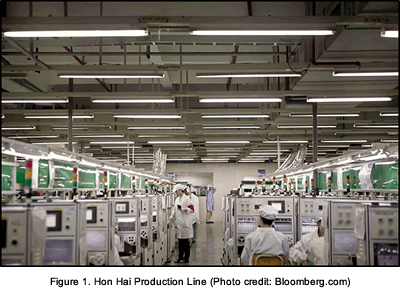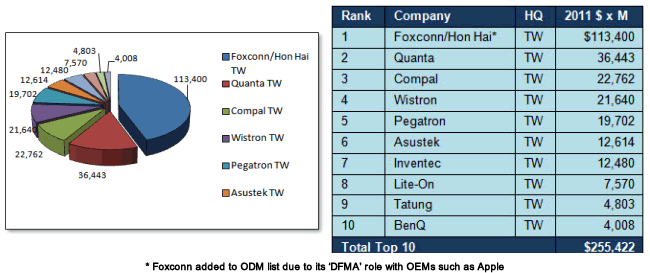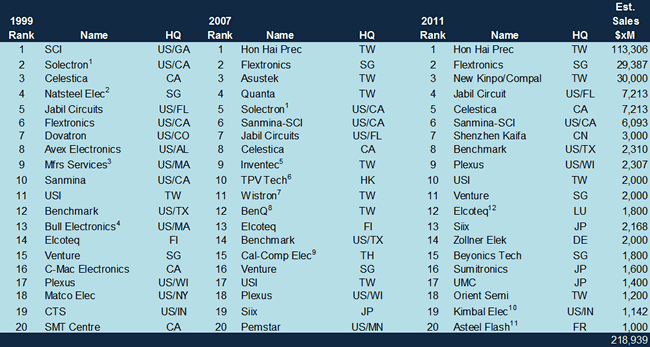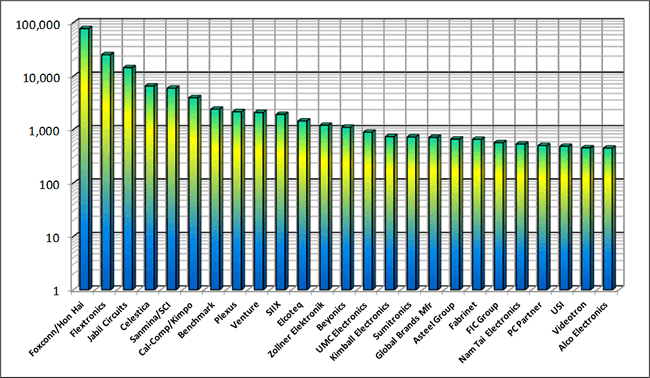Contract Manufacturing: A $300B Industry
 Electronic Manufacturing Services (EMS) and Original Design Manufacturers (ODM) have been in existence for well over a decade. The terms evolved from subcontract manufacturing, motherboard manufacturing, and “board-stuffing” operations into a sophisticated $300B EMS/ODM industry. We could differentiate EMS suppliers from board assembly operations and ODMs from EMS suppliers because their roles have been historically different; but those distinctions are now blurred. EMS providers started as subcontract manufacturers; ODMs started with product design expertise (such as notebook PCs) that leveraged DFMA (Design for Manufacturing and Assembly) efficiencies in a low labor cost environment.
Electronic Manufacturing Services (EMS) and Original Design Manufacturers (ODM) have been in existence for well over a decade. The terms evolved from subcontract manufacturing, motherboard manufacturing, and “board-stuffing” operations into a sophisticated $300B EMS/ODM industry. We could differentiate EMS suppliers from board assembly operations and ODMs from EMS suppliers because their roles have been historically different; but those distinctions are now blurred. EMS providers started as subcontract manufacturers; ODMs started with product design expertise (such as notebook PCs) that leveraged DFMA (Design for Manufacturing and Assembly) efficiencies in a low labor cost environment.
The EMS industry began with the Huntsville, Ala., company Solectron, one of IBM’s early industry-leading subcontract manufacturers along with SCI. Preceding them, most large OEMs had their own PCB shops and board assembly operations. PCB manufacturing had some environmental issues and over time went from 80 to 90% in-house OEM PCB manufacturing to almost 100% merchant suppliers. Some of these PCB shops saw an opportunity in value-added services. Thus, the board assembly business started, aided by automated pick-and-place equipment. It evolved into board assembly/system-build EMS activities and, eventually, to a global EMS/supply chain discipline.
This business model for the electronic equipment industry makes a lot of sense to OEMs:
- It allows them to off-load resource-draining manufacturing operations and a lot of personnel
- Subcontractors have significantly lower overhead and gross margins than OEMs
- EMS firms focus on their core mission: electronic manufacturing with the latest equipment and knowhow
- EMS firms are better able to “offshore” and insulate OEMs from any resulting negative issues
- Both firms enjoy economy-of-scale in their areas of expertise: EMS in manufacturing and OEM in R&D, design, marketing and distribution
 ODMs began in Taiwan and, for the most part, remain headquartered there (with assembly in mainland China and elsewhere). Their targeted system design activity had similar roots to board-stuffing: the goal was to offer value-added services for OEMs without competing with OEMs. The nascent ODM industry developed industry/government partnerships aimed at building on Taiwan’s PCB and motherboard manufacturing capability into value-added. The leverage between building systems and boards was 20:1. This gained substantial export trade dollars for a country with limited natural resources and placed Taiwan at the epicenter of the fast-growing computer industry. This was successfully accomplished to where Taiwan designs and builds more than 90% of today’s Notebook/Ultrabook computers, mostly for OEMs. Along the way there was a story that Terry Gou, founder of Foxconn/Hon Hai Precision, built factories in China for Apple and Dell, and took Steve Jobs and Michael Dell there to see them. The rest is history. Apple’s explosive success with iPods, iPhones, and iPads probably would not have been possible without Foxconn or another EMS/ODM like them.
ODMs began in Taiwan and, for the most part, remain headquartered there (with assembly in mainland China and elsewhere). Their targeted system design activity had similar roots to board-stuffing: the goal was to offer value-added services for OEMs without competing with OEMs. The nascent ODM industry developed industry/government partnerships aimed at building on Taiwan’s PCB and motherboard manufacturing capability into value-added. The leverage between building systems and boards was 20:1. This gained substantial export trade dollars for a country with limited natural resources and placed Taiwan at the epicenter of the fast-growing computer industry. This was successfully accomplished to where Taiwan designs and builds more than 90% of today’s Notebook/Ultrabook computers, mostly for OEMs. Along the way there was a story that Terry Gou, founder of Foxconn/Hon Hai Precision, built factories in China for Apple and Dell, and took Steve Jobs and Michael Dell there to see them. The rest is history. Apple’s explosive success with iPods, iPhones, and iPads probably would not have been possible without Foxconn or another EMS/ODM like them.
Today, Foxconn is by far the largest manufacturing services supplier in the industry (although the scale of their market share might be considered problematic in some ways). Foxconn is different from Taiwan’s traditional ODMs in that it concentrates on turnkey manufacturing technology with technologically advanced workflow and processes to match Apple’s sleek equipment designs. It is sort of a mix between ODM and EMS. The key is they don’t compete with their customers.
Industry Today
- The EMS industry has gone through a major transition, and not without economic travails:
- There have been substantial mergers and acquisitions, due to the tough financials in this business model.
- The industry is very cyclical, heightened by recent deep recessions in 2001-02 and 2008-09.
- EMS has come to be dominated by Foxconn, which has its own set of growing pains in China.
There are major dichotomies for OEMs to deal with, such as labor strife in Chinese factories, which affects public relations; thin profitability in the EMS ranks to fund advanced manufacturing research and development; too much dependence on one country (China) in the event of a major work stoppage; and challenges in the supply chain now at arm’s length from OEM control.
For the connector industry, the shift from OEM to EMS/ODM has been particularly challenging; nothing like it existed before, and some long-term OEM relationships were compromised. The industry is now working through more arms-length relationships aided, yet intensified, by the internet. This is further complicated because connector suppliers now have two customers to satisfy rather than one for each transaction. Other factors affecting this fragmented relationship include:
- Cultural differences between East and West in an outsourced environment
- Longer supply lines, often requiring relocation of management and engineering to Asian facilities
- The need to set up manufacturing facilities in foreign EMS mega-manufacturing campuses
- Difficulties in tracking compensation through the global sales channel
- Price erosion, which can be more prevalent, increasing exposure to low-cost knock-off competitors.
Throughout this transition, and ongoing, account management became a major challenge with many nuances.
Today, most companies have learned to deal with the situation and have developed ways to close the loop between OEM and EMS customers, with the latter being somewhat of a hybrid between an OEM and distribution relationship. In many cases, Asian divisions of NA and EU connector companies have taken on the primary role in consumer, computer, and even some industrial applications.
Top 10 ODM 2011

Top 20 EMS Suppliers 1999-2007-2011
Sources: EDN Magazine, CircuitsAssembly Magazine, EETimes, and some estimates

See EDN for historical rankings
Notations:
- Solectron acquired by Flextronics
- Natsteel acquired by Solectron
- Mfrs Services acquired by Celestica
- Bull Electronics acquired by Celestica
- Inventec is a Taiwan ODM: Notebooks, Servers, Phones
- TPV Technology is a display ODM
- Wistron is a Taiwan ODM spun off from Acer Computer
- BenQ spun off from Acer. Acquired Siemens Mobile Phone bus. BenQ spun off Qisda ODM/EMS firm. BenQ reformed as OEM
- Cal-Comp is part of New Kinpo Group/TW Sales target for 2012 is $40Bn, including Compal subsidiary
- Kimball Electronics emerged from W.W. Kimball electronic organ company
- Asteel acquisitions: Flash Electronics, MRP, Catalyst Mfg, EN ElectronicNetwork
- Elcoteq filed for bankruptcy in 2011
The Top 50 EMS Suppliers for 2010 are listed in Circuits Assembly Magazine.
Chart 2: Top EMS 2010 $ x 1,000 Logarithmic Scale based CircuitsAssembly data

- Electric Vehicles Move into the Mainstream with New EV Battery Technologies - September 7, 2021
- The Dynamic Server Market Reflects Ongoing Innovation in Computing - June 1, 2021
- The Electronics Industry Starts to Ease Out of China - November 3, 2020



